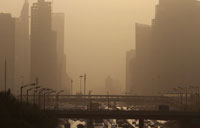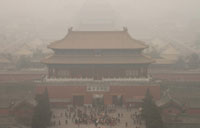|
 |
| Pollution casts pall over cities' livability |
|
 |
| Beijing fines 652 firms for pollution in 4 months |
The statistics show that air quality in 74 Chinese cities met national standards 70.6 percent of the time in April, an improvement over March's 62.3 percent. The number of cities scoring above 80 percent also rose, from 22 in March to 29 in April.
In contrast with the progress made by the 74 major cities as a whole, air quality in the most-polluted area - the Beijing, Tianjin and Hebei province cluster - got slightly worse in April. Nine cities out of the 13 in this region appeared on the list of the top 10 cities with the worst air quality. The number in March was seven.
As the seasons changed, so did major pollutants in different regions. PM2.5 - particulates smaller than 2.5 microns that are capable of penetrating the lungs and harming health - was not as dominant among pollutants in April as in March.
For the Beijing, Tianjin and Hebei province cluster, PM2.5 was still responsible for most of the days with bad air quality. But the proportion of polluting days caused mainly by PM10, which are larger particles, rose by 10 percentage points in this region from March to April.
The region has entered the season when sand dust becomes common, Zhang Mingying, a senior engineer from the Beijing Meteorological Bureau, told the Beijing Morning Post in late March.
Zhang said that normally the impact of sand dust on air quality includes reducing visibility and raising PM10 levels.
The major pollutants in the Yangtze River Delta changed from PM2.5 and PM10 in March to PM2.5 and ozone in April.
For the hotter and more humid cities in the Pearl River Delta, ozone became the top pollutant in April, accounting for 73.7 percent of the bad-air days. In March, more than 85 percent of high-pollution days were caused by PM2.5.
"Although ozone in the stratosphere blocks high levels of ultraviolet from reaching Earth, it is a pollutant at low altitude," said Chai Fahe, vice-president of the Chinese Research Academy of Environmental Sciences.
Ozone pollution is easily shrugged off by the public because it does not affect visibility, he said.
However, research has shown that a high level of ozone can irritate the eyes and may cause irreversible damage to the lungs and central nervous system.
The 10 cities with the worst air quality in April were Xingtai, Tangshan, Shijiazhuang, Handan, Baoding, Qinhuangdao and Langfang, all in Hebei province; Jinan in Shandong province; and Tianjin and Beijing.
The PM2.5 level in the Beijing, Tianjin and Hebei province cluster dropped by about 10 percent in the first quarter compared with the same period last year. Air quality in the Yangtze River Delta and the Pearl River Delta is also improving.
However, solving airborne pollution still requires more time and effort, Vice-Premier Zhang Gaoli said during a meeting on air pollution control in Beijing on Thursday.
Zhang said joint prevention and control efforts among different provinces is the most efficient way to deal with regional air pollution.
Contact the writer at wuwencong@chinadaily.com.cn
